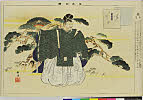Shikisanban
しきさんばん 式三番
Shikisanban ("The Three Ceremonial Pieces") , also referred to as Okina 翁, is a ritual noh piece performed on auspicious occasions to celebrate peace, long life, prosperity, and fertility. On the noh stage today Shikisanban is distinct from other plays in several ways. The dancers don their masks on stage; the instrumentalists include three kotsuzumi small hand drum players, rather than the standard one; and the chorus sits behind the instrumentalists rather than at the side of the side. Many folk variations of Shikisanban are performed in Shrines throughout Japan. The common feature for all is the use of the white old man's mask of Okina (Hakushiki-jō) 白式尉 and the black old man's mask of Sanbasō 三番叟 (Kokushiki-jō 黒式尉). Sometimes a third mask, Chichinojō 父尉, is also used. (MB)
Noh Kyogen
[[Category:noh|title or Romoaji]
Ritual preparation before the performance
Traditionally the actors go through a period of abstention prior to the performance. On the day, the Okina and Sambasō masks are set up on an altar in the backstage area and given offerings of sake and salt. The performers gather in front of this altar and drinking from one cup passed around join in harmony.
Roles
Men bako, mask bearer, dressed in kamishimo
Senzai 千歳, the purifier, unmasked, dressed in matched hitatare 直垂 suit with a design of abroken ice pattern, cranes, and turtoises.
Okina, benevolent old man played by the shite actor wearing a white-faced Okina (Hakushiki-jō) mask, Okina kariginu 狩衣, sashinuki 指貫, Okina eboshi 烏帽子, and Okina fan.
Sanbasō, old man of fertility played by a kyōgen actor wearing a dark-faced Sanbasō 三番叟 (Kokushiki-jō 黒式尉) mask, dark matched hitatare suit with design of cranes, tortoises, and pines.

Woodblock print of the masks of Okina and Sanbasō above, artist unknown,1911. (Below are Kojo, an old man, and uba, an old woman.
https://data.ukiyo-e.org/ritsumei/images/arcUP1493.jpg
Summary
After the mask bearer brings out the box containing the mask, the shite player comes out, unmaksed, and bows at the front of the stage. Then Senzai purifies the stage area by marking the corners with stamps and sleeve manipulations. During this time the mask is placed on the shite's face. After Senzai has finished, Okina stands at center stage and sings of the boundless, booming waterfall, of the tortoise, crane, and of the blessings of the deities. To instrumental music with three kotsuzumi 小鼓drummers, the masked shite slowly goes to the down stage right corner then the down stage left corner, then center stage, where he flips the left sleeve over his head and covers his face with the open fan. This represents harmony of heaven, earth and man. The shite praises long life and then removes the Okina mask and exits.The stick drum (ōtsuzumi 大鼓) joins the instrumentalists and the kyōgen actor performs two dances, mominodan (unmasked) and suzunodan (masked). Mominodan, like Senzai's dance, serves to purify the stage and awaken the earth god with strong stanmps and flying leaps. For suzunodan, Sambasō holds a stick with jingle bells and shakes it towards the ground as if planting seeds and encouraging their growth. (MB)

Woodblock print of Okina by Tsukioka Kōgyo, Nōgaku zukai, 1897 https://data.ukiyo-e.org/ritsumei/images/arcUP0842.jpg

Woodblock print of Sambasō, artist unknown, 1911, https://data.ukiyo-e.org/ritsumei/images/arcUP1464.jpg
Private
Kabuki
[[Category:Kabuki|title or Romoaji]
XXXX
XXXX
Private